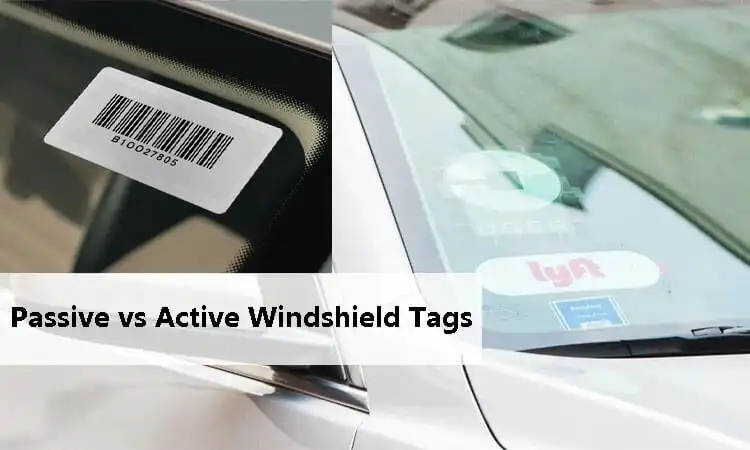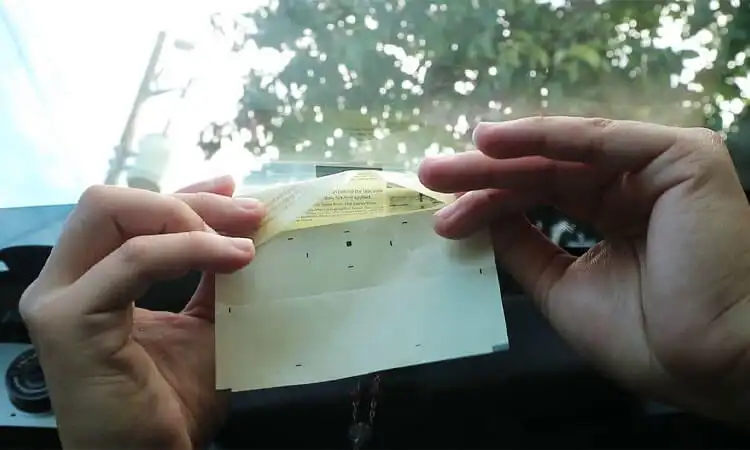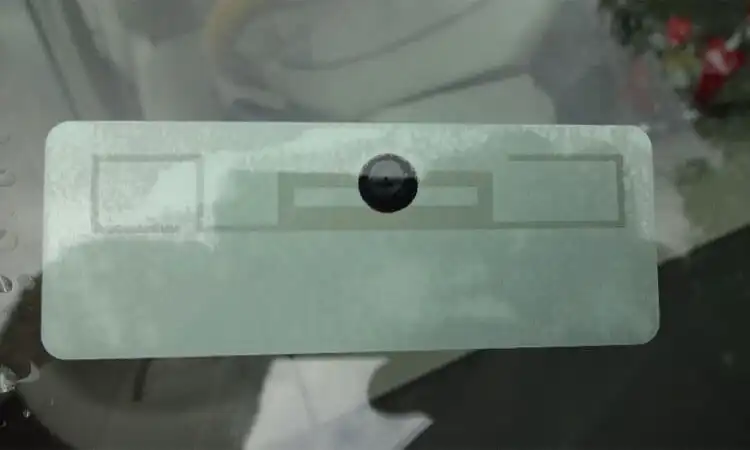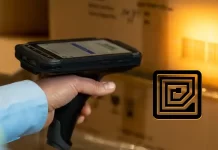Are you tired of long queues at toll booths and parking lots? Windshield tags can help you save time and hassle. These RFID tags are affixed to your car’s windshield, allowing contactless payment and access control. RFID technology has revolutionized how we pay tolls, parking, and more. There are two types of RFID tags, passive and active. In this guide, we will explore the working principle of windshield labels and the pros and cons of each type. We will also provide tips on properly placing and removing RFID tags on your windshield.
What is a Windshield Tag?
A windshield tag is a device that uses radio frequency identification (RFID) technology to identify a vehicle. It is usually attached to the inside of a car’s windshield. It allows drivers to quickly and easily pass through toll booths or access controlled areas without stopping to pay or present identification. RFID technology uses a small chip and antenna to send and receive signals to and from a reader. The tag does not require any power source and is activated by the signal from the reader. There are two types of RFID tags, passive and active, with different ranges and costs. RFID windshield stickers are becoming increasingly popular for their convenience and efficiency in tolls, parking, and access control.
In addition to tolls and parking, RFID windshield tags are also used for access control. They can grant access to restricted areas such as gated communities, office buildings, and universities. RFID windshield stickers are a convenient and reliable method for managing access to these areas. Because they can be easily activated or deactivated as needed.
Read more: Everything You Should Know About RFID Tags for Car
Where do RFID Stickers Go on the Windshield?
Placing the windshield label in the correct location will help it function effectively. A windshield replacement toll tag is typically mounted inside a car’s windshield for easy access and identification. Additionally, different types of windshield mount tags, such as windshield RFID tags, windshield ID tags, and windshield pass tags, use radio frequency identification technology to quickly and easily identify a vehicle.
Windshield sticker tags are becoming increasingly popular due to their convenience and efficiency in tolls, parking, and access control. RFID technology uses a small chip and antenna to send and receive signals to and from a reader, and the tag does not require any power source.
Read the Video: Great Smoky Mountains National Park Uses Windshield Tags to Identify Parkers
The working principle of windshield tags is based on RFID technology. RFID tags consist of a microchip and an antenna, which work together to transmit information to a reader using radio waves.
The reader sends a radio signal when a car with an RFID tag approaches a reader. The antenna on the tag receives this signal and sends back a response, which contains the tag’s unique identification number.
The reader then captures this response and sends it to a computer system. It uses the information to process the transaction or grant access.
Passive RFID tags do not require a battery, and their operation is based on the energy emitted by the reader. The reader sends out a radio signal that powers the tag. This allows it to respond with its identification number.
On the other hand, Active RFID tags have a built-in battery and can transmit signals over longer distances. They are typically used in applications requiring longer read ranges, such as in toll road systems.

There are two types of RFID tags, passive and active, with different ranges and costs. RFID windshield tags are also used for access control to restricted areas, such as gated communities, office buildings, and universities, and can be easily activated or deactivated as needed.
Active RFID Windshield Tag
Active RFID windshield sticker tags are a type of RFID tag that uses a built-in battery to transmit signals over long distances. These tags are commonly used in toll roads, parking lots, and other applications that require long-range communication between the tag and the reader.
The built-in battery in an active RFID windshield label allows it to transmit signals even when it is not in the immediate vicinity of a reader. This means an active tag can be read from several meters away, making it ideal for applications that need to be read at high speeds.
Active windshield stickers can also be used for real-time tracking of vehicles. The battery-powered tags continuously transmit their location to a reader or base station. This allows it for real-time tracking of the vehicle’s location and movement.
Active RFID tags also have a longer lifespan than passive tags. Because the battery can be replaced when it runs out of power. This means that active windshield tags can be used for many years, making them a cost-effective solution in the long run.
However, active RFID windshield stickers are generally more expensive than passive windshield sticker tags and require more maintenance due to the need to replace the battery. Additionally, active tags may be larger and heavier than passive ones, making them more difficult to affix to a windshield.
Passive RFID Windshield Tag
Passive RFID windshield tags are a type of RFID tag that does not require a battery to operate. These tags are typically used in applications that require proximity communication between the tag and the reader.
RFID passive windshield stickers use radio waves from a reader to power the tag’s microchip and transmit information back to the reader. This means the tag only operates when it is near a reader.
RFID passive windshield sticker tags are generally smaller and lighter than active tags, which makes them easier to affix to a windshield. They are also less expensive than active tags, making them a more cost-effective solution for many applications.
However, passive RFID windshield stickers are limited in range, which may make them less suitable for applications that require long-range communication. They also require a reader with a strong electromagnetic field to power the tag, which may limit their use in certain environments.
How to Place Passive RFID Tag on Windshield

Placing a passive RFID tag on a windshield is a straightforward process. Here are the steps:
- Clean the windshield with a glass cleaner to remove any dirt or grime.
- Peel the backing off the RFID tag to expose the adhesive.
- Place the tag on the windshield, ensuring it is centered and facing the correct direction.
- Press down firmly on the tag to ensure that it is securely attached to the windshield.
- Test the tag with a reader to ensure that it is functioning properly.
It is important to note that the tag’s placement on the windshield can affect its performance. Labels should be placed where they are easily scanned and do not obstruct the driver’s view. Additionally, the tag should not be placed near metallic objects or other sources of interference, as this can affect its ability to communicate with the reader.
How to Remove an RFID Tag from My Windshield
Removing an RFID tag from a windshield can be a bit tricky, as the tag is designed to adhere strongly to the glass. But there are several ways to take down the windshield label:
- Use a heat gun or hair dryer to warm up the adhesive and soften it. Then, use a plastic scraper or credit card to pry the tag off the windshield carefully.
- Use a solvent such as rubbing alcohol, acetone, or Goo Gone to dissolve the adhesive. Rub the solvent into a cloth or cotton ball over the tag until the adhesive dissolves. Then, use a plastic scraper or credit card to remove the tag from the windshield.
It is important to be gentle when removing an RFID tag from a windshield, as excessive force or scraping can damage the glass. If the tag cannot be removed easily, it may be best to leave it in place or seek professional assistance to avoid damaging the windshield.
With the right tools and techniques, removing an RFID tag from a windshield without causing damage is possible. However, it is important to be careful and take appropriate precautions to ensure a safe and successful removal process.
RFID windshield tags offer several advantages over other identification and tracking technologies. These include:
- Improved security: Windshield RFID tags can provide more secure identification than traditional methods such as barcodes or magnetic stripes. Because criminals cannot easily copy or tamper with them.
- Convenience: Windshield RFID tags can be read from a distance without requiring a line of sight. This makes them more convenient than other technologies requiring physical contact or proximity.
- Accuracy: Windshield RFID tags can provide more accurate tracking and identification than other technologies since they can be read quickly and reliably, even in challenging environments.
- Speed: Windshield RFID tags can be read quickly and without the need for manual intervention. This makes them ideal for applications that require rapid identification and tracking.
- Durability: Windshield RFID tags are typically more durable and long-lasting than other technologies. Such as barcodes or magnetic stripes, making them well-suited for use in harsh environments or high-use applications.
- Customized: RFID windshield stickers can be customized to meet the specific needs of different applications and industries. For example, they can be programmed with unique identifiers or data fields to track a vehicle’s location, status, or history.
RFID windshield sticker tags offer a range of benefits that make them an attractive option for a variety of different applications and use cases. By leveraging the power of RFID technology, organizations can improve security, increase efficiency, and enhance the overall customer experience.
While RFID windshield tags offer many benefits, there are also some potential disadvantages to consider. These include:
- Privacy concerns: Since RFID tags can be read from a distance, there are concerns about the potential for unauthorized tracking or surveillance.
- Cost: RFID tags can be more expensive than other identification technologies, such as barcodes or magnetic stripes. This may be a barrier to adoption for some applications.
- Maintenance: RFID systems require regular maintenance and calibration to ensure optimal performance, which can be time-consuming and costly.
- Interference: Radio interference from other devices or materials can affect the performance of RFID systems. This makes them less reliable in some environments.
- Limited range: Passive RFID tags have a limited read range, which can be a limitation in some applications where longer-range identification is required.
- Environmental limitations: Some RFID tags may not function well in extreme environmental conditions, such as high temperatures or exposure to moisture or chemicals.
Despite these potential disadvantages, RFID windshield tags remain a popular and valuable technology for various applications where accurate and reliable identification and tracking are required. Users should carefully consider these factors when choosing an RFID system and implement appropriate measures to address potential issues.
RFID windshield tags offer a convenient and efficient way to manage vehicle access and improve security. While some disadvantages exist, the benefits of using RFID tags are clear. By understanding the different types of tags available, how they work, and how to install and remove them properly, vehicle owners can make informed decisions about using RFID technology.
RFID Windshield Tag Problems
-
What is an RFID windshield tag?
A radio frequency identification tag is placed on vehicle windshields for electronic toll collection or parking payments.
-
How do RFID windshield tags work?
They contain an RFID chip and antenna to store and transmit vehicle information when RFID readers scan at toll plazas or parking garages.
-
What information is stored on an RFID windshield tag?
Vehicle license plate, registration, account details, and a unique ID for the tag.
-
How are RFID windshield tags attached to vehicles?
They are designed to securely adhere to the inside of a vehicle windshield, typically in the bottom corner. They use a strong adhesive and heat-activated bonding.
-
What are the benefits of RFID windshield tags?
Convenience, speed, accuracy, and reserved parking spots. No stopping at toll plazas or calculating payments. Faster entrance and exit from garages.
-
Who issues RFID windshield tags?
They are provided by toll authorities, parking operators, vehicle rental agencies, and some private RFID tag providers and resellers.
-
How much do RFID windshield tags cost?
Cost varies but typically $5 to $20 per tag depending on the issuer, vehicle, and additional features. Discounts may apply for multiple tags.
-
Can RFID windshield tags be reused?
Some tags are reusable for multiple vehicles, while others are permanently affixed to a single vehicle. Reusability depends on the issuer, tag, and windshield adhesion design.
-
Can RFID windshield tags be replaced?
Yes, RFID windshield tags can be replaced if they become damaged, illegible, or detached over time. Owners will need to obtain a replacement tag from the original issuer.
-
What are the disadvantages of RFID windshield tags?
Upfront and replacement costs, lack of universal compatibility between systems, and lack of redundancy if the tag fails to read properly at a toll plaza or garage entrance.
-
What is the purpose of RFID tags in cars?
The purpose of an RFID tag in a car is to identify and track the vehicle using radio frequency signals. This can be used for various purposes, such as toll collection, parking management, and access control. RFID tags can also be used to track the movement of goods and people in logistics and supply chain management. The use of RFID tags in cars and other vehicles is becoming increasingly common as the technology becomes more affordable and widespread.
-
How do you get an RFID sticker off a windshield without damaging it?
Suppose you want to tear off the RFID tag from the windshield without damaging it. You can use a plastic scraper or a credit card to scrape the edges of the label gently. Then apply heat with a hair dryer or heat gun to loosen the adhesive. Slowly peel the RFID windshield sticker off while continuing to apply heat, being careful not to pull too hard or quickly. Any remaining residue can be removed with a commercial adhesive remover or rubbing alcohol. It is important to be gentle and patient to avoid causing damage to the windshield and to follow proper safety precautions when using any tools or chemicals.











